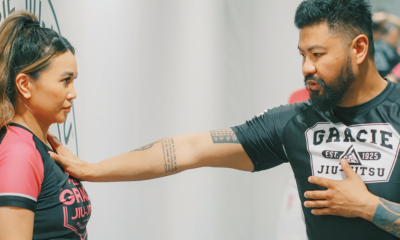Womens Self Defense
The Legalities of Defending Yourself: Understanding Judicial Interpretations

In today’s world, self-defense is a fundamental right that individuals possess to protect themselves from harm. Whether you are facing a physical threat or an imminent danger, the ability to defend oneself is crucial. However, the legalities surrounding self-defense can be complex and often subject to judicial interpretation.
Self-defense is typically defined as the use of force to protect oneself or others from harm. In most jurisdictions, individuals have the right to defend themselves with reasonable force when faced with an immediate threat of harm. This includes using force to prevent an assault, robbery, or other violent acts.
One of the key factors in determining the legality of self-defense is the concept of proportionality. This means that the force used must be proportional to the threat faced. In other words, you cannot respond to a verbal insult with physical violence. The force used must be necessary to protect yourself or others from harm.
Another important consideration is the concept of reasonableness. The actions taken in self-defense must be considered reasonable under the circumstances. This includes considering factors such as the severity of the threat, the individual’s physical abilities, and the availability of other means to protect oneself.
In some cases, self-defense can be a defense to certain criminal charges, such as assault or battery. However, the burden of proof is typically on the defendant to prove that they acted in self-defense. This can be a challenging task, as there may be conflicting evidence or witness testimony.
Judges and juries play a crucial role in interpreting the legalities of self-defense. They must carefully consider the facts of the case, the applicable laws, and any relevant precedents in reaching a decision. Judges will instruct juries on the legal standards for self-defense, including the requirement of proportionality and reasonableness.
In recent years, there have been high-profile cases involving self-defense, such as the George Zimmerman case in Florida and the Kyle Rittenhouse case in Wisconsin. These cases have sparked debates about the role of self-defense in society and the nuances of the legalities surrounding it.
As individuals, it is important to understand the legalities of defending yourself and to be aware of your rights in a threatening situation. It is also important to seek legal counsel if you find yourself facing criminal charges related to self-defense.
In conclusion, self-defense is a fundamental right that individuals possess to protect themselves from harm. However, the legalities surrounding self-defense can be complex and subject to judicial interpretation. Understanding the concepts of proportionality and reasonableness, as well as seeking legal counsel if needed, are crucial steps in defending yourself effectively and within the confines of the law.
Womens Self Defense
SELF-DEFENCE TECHNIQUES FOR WOMEN || 5-Minute Recovery Tips For Different Situations!

SELF-DEFENCE HACKS YOU NEED TO KNOW We prepared unusual self-defense techniques for brave women and easy …
source
Womens Self Defense
"Defending Your Rights: Legal Considerations for Self-Defense Actions"

Self-defense is a fundamental legal concept that allows individuals to protect themselves from imminent harm. However, the application of self-defense laws can be complex and varies significantly by jurisdiction. This article explores critical legal considerations when evaluating self-defense actions, helping individuals to understand their rights and responsibilities.
Understanding Self-Defense
Self-defense refers to the right to use reasonable force to protect oneself from physical harm. This principle is rooted in both state and common law, emphasizing that individuals should not be required to retreat from danger when the threat is immediate and unavoidable. The key elements of self-defense generally include:
- Immediacy of Threat: The threat must be imminent, meaning that there is a genuine risk of being harmed.
- Proportionality: The force used in self-defense should be proportional to the threat faced. For example, using deadly force may be justifiable only in response to a threat of death or serious bodily harm.
- Reasonableness: The actions taken in self-defense must be reasonable from the perspective of an average person in the same situation.
Types of Self-Defense Claims
Legal frameworks often recognize two primary types of self-defense claims:
1. Personal Self-Defense
This claim applies when an individual uses force to protect themselves from an attack. It is crucial to prove the immediacy and severity of the threat to justify the use of force.
2. Defense of Others
Individuals may also claim self-defense if they are acting to protect someone else from imminent harm. The same legal principles apply: the perceived threat must be immediate, and the response must be proportional.
Legal Considerations
A. Jurisdictional Variations
Self-defense laws are influenced by state legislation, which can lead to significant differences in how these laws are enforced. For example:
- Stand Your Ground Laws: Some states have enacted laws that allow individuals to use force without the duty to retreat, even in public spaces.
- Castle Doctrine: This legal doctrine provides individuals with the right to use force, including deadly force, to protect themselves within their own homes.
These laws can dramatically affect the legal outcomes of self-defense cases, and understanding local legislation is essential.
B. The Role of Evidence
In self-defense cases, evidence plays a crucial role in substantiating the claim. This may include:
- Witness Testimonies: Eyewitness accounts can provide corroboration of the threat faced and the reasonableness of the response.
- Surveillance Footage: Video evidence may clarify the context of the encounter, portraying the aggressiveness of the threat.
- Physical Evidence: Injuries, weapons involved, and other physical evidence can also help establish the circumstances surrounding the incident.
C. Aftermath and Legal Repercussions
Even when self-defense claims are legally justified, individuals may still face legal challenges. This could include:
- Criminal Charges: Law enforcement may still charge individuals with crimes related to the incident, which may require a legal defense.
- Civil Liability: Victims of the encounter may pursue civil lawsuits for damages, complicating matters for the individual invoking self-defense.
Conclusion
Defending your rights through self-defense is a nuanced area of law that requires a careful understanding of local regulations and legal principles. Individuals faced with a potentially dangerous situation should be aware of their rights and the legal ramifications of their actions. Consulting with legal professionals who specialize in self-defense laws is crucial to navigating this complex landscape. By understanding the core principles of self-defense, individuals can better protect themselves while minimizing the risk of legal repercussions.
Womens Self Defense
How Neighborhood Watch Programs Can Help Keep Communities Safe

Absolutely! I’m excited to help empower women through knowledge and self-defense skills. Just let me know the article title, and I’ll get started!
-

 Womens Self Defense10 months ago
Womens Self Defense10 months agoNew Legislation Empowers Women to Defend Themselves
-

 Self Defense News1 year ago
Self Defense News1 year agoShe was convicted of killing her abusive boyfriend. Now a Maple Grove woman is home awaiting a new trial.
-

 Self Defense News1 year ago
Self Defense News1 year agoSelf-Defense for All: The new Gracie Jiu-Jitsu Pasadena is for everyone | Online Features
-

 Womens Self Defense1 year ago
Womens Self Defense1 year agoTop 5 Self-Defense Techniques Every Woman Should Know
-

 Womens Fitness1 year ago
Womens Fitness1 year agoXtreme Bodyweight HIIT (Lots of Jumping!) | Joanna Soh (Fio Series)
-

 Womens Self Defense6 months ago
Womens Self Defense6 months agoUnderstanding State-by-State Variation in Self Defense Laws
-

 Womens Preparedness1 year ago
Womens Preparedness1 year agoThe Importance of Self-Sufficiency Skills in Today’s World
-

 Womens Preparedness1 year ago
Womens Preparedness1 year ago10 essential skills for surviving in the great outdoors



